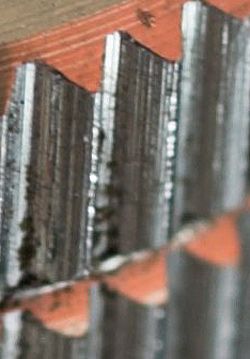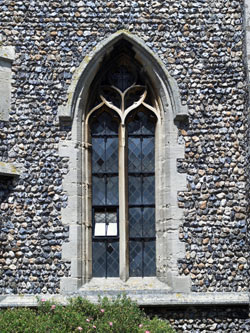Olympus Zuiko Digital ED 50mm f/2 Macro
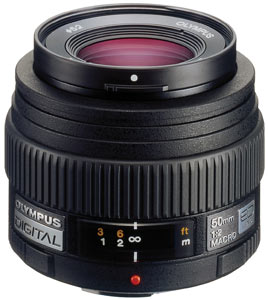 Specifications
Specifications
- Focal length 50mm
- Max Aperture f/2
- Angle of view 24° (on 4/3rds mount)
- Construction 11/10 elements/groups
- Closest focus 0.24m
- Filter size 52mm
- Dimensions 71x65.1mm
- Weight 0.30kg
- Mount 4/3rds system
- Price (RRP)
Build and handling
Olympus claim that this lens is a pro spec and therefore splash proof. It certainly seems well made and there are no loose or wobbly bits, even with the front element extended by the 35mm it comes out of the body at its closest focus point of 240mm. Unfortunately, to get it there, the AF system makes a low grating noise and it is certainly not quick. Once the lens arrives at the point of focus, it gives a couple of jerks, as if to check for itself that it is in the right place. Having made up its mind, it is accurate.
The only control on the lens is the manual focus ring, and this can only be made operable through the camera menu. When activated, it requires two and three-quarter full turns of the ring to make its way through the range with the same grating noise as the AF makes. When the camera is switched off, the lens retracts automatically to the infinity position. There is also a distance window placed centrally on the barrel and marked in both metres and feet but no attempt at a depth-of-field scale. The seven-blade aperture will only stop down to f/22 which is a little shy for a full macro lens.
Optical quality
The optical qualities of this lens are quite good. Controls of chromatic aberrations are some of the best we have seen, with measurements in Imatest being in the tiny fractions of a pixel. Contrast is also fairly good and the colour balance is neutral. As you would expect of a modern prime lens, the control of distortions is also good, with a figure of 0.4% pincushion measured in the distortion module and undetectable by eye.
Resolution is reasonably good with only the widest apertures dropping off at the edges a little more. However, for a Macro lens, the resolution average peaks far to early, hitting its top spot between f/4 and f/5.6 and we feel it would make a far better lens for portraiture than macro-photography where smaller apertures are the norm.
 With the 2x crop factor of the 4/3rds system this lens is well suited to subjects like flowers where you need a little space between the subject and the camera. | 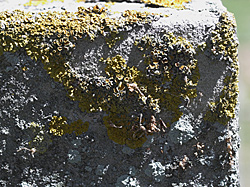 The contrast is fairly good, as seen here on this shot of lichen |
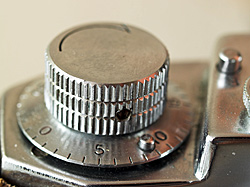 Here, a 100% crop from the centre of the full frame at the closest focus point of 1:2 shows the detail the lens is capable of recording. All shots taken on Olympus E-500 |
|
Click on each comparision photo below to view full size versions
Below is our lens test data. To find out how to use these graphs look at this article: How we test lenses
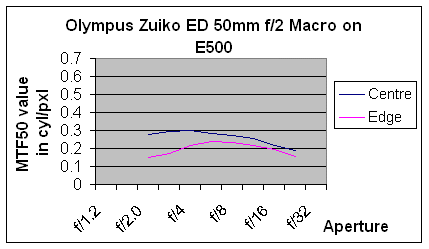
Verdict
With many people utilising manual focus and using a rocking technique for macro-photography, the restrictions of this lens and its system would soon become exasperating although for table-top use the lens is adequate. However, with a reproduction ratio of only 1:2 it is not a true macro lens. On the 2x crop factor of the 4/3rds system, it would be far better utilised as a portraiture lens. It can be used with Olympus’ EX25 extension tube to achieve a ratio of 1:0.98 but even that is not quite true macro.
In summary, the positive points of the Olympus Zuiko ED 50mm f/2 Macro are:
![]() Good build quality
Good build quality
![]() Good optically, although peaks early for a ‘macro’.
Good optically, although peaks early for a ‘macro’.
The negative points are:
![]() Focussing system is atrocious.
Focussing system is atrocious.
![]() Only 1:2 reproduction ratio, not true macro.
Only 1:2 reproduction ratio, not true macro.
![]() Cheaper alternatives with better performance on their way.
Cheaper alternatives with better performance on their way.
Check the latest price for the Olympus Zuiko ED 50mm f/2 Macro here
Discuss this lens and other related lens subjects here
Test by Ian Andrews www.wildaboutkent.com
I am also baffled by the hang-up on this lens not being a full macro. I understand the optics: the image at the CCD plane is only half the size of the subject being photographed at maximum magnification. Okay...so what? How much effective magnification you can get from a macro lens depends on lens resolution and pixel density, and not on the size of the image at the film plane. The final result, such as a photographic print, tells the real story. This is a very sharp lens. I can make great 12x16" (30x40cm) prints of an object which is twice the size of the 13x17.3mm sensor, which means a subject that is about 1x1.36" (26x35mm). I haven't tried larger prints.
On the AF criticisms of the Photodo review, they may have a point, but that has not been a problem for my shooting. If one needs to shoot a moving insect, maybe there's a problem. I generally shoot static objects.
I can see that a smaller aperture, say f/32, might be handy for full macro of non-flat subject matter, but I am usually shooting with selective DOF. So it depends what you're doing.
- "Only 1:2 reproduction ratio, not true macro." FOV of 4/3 System is 2. So, image of 4/3 lens which 1:2 ratio is same 1:1 of file 35mm system. If you think it not true macro, you will think 1:1 of file 35mm is not true macro too!!
If an object is 10mm long, then at a ratio of 1:1, it will be 10mm long on the sensor/film. AT 1:2, the object will be represented on the sensor at 5mm, immaterial of whether that sensor is 4/3rd, APS, DX, or 35mm full frame.
By representing a 10mm object at 5mm on the sensor, this lens is NOT TRUE MACRO.
It only becomes TRUE MACRO once the object is represented at life size (or larger)
Ian
Anywhere, If 1:2 ratio is not true macro then Macro FD 50mm f3.5, Macro FD 100 f4, EF Macro 50mm f2.5 and Macro-Elmarit-R 60mm f/2.8 is not true macro because its magnification is 1:2(magnification of Macro Elmar-M 90mm f4 is 1:3). Can you confirm (or reference) to message "The true macro lens is lens which magnification is 1:1 for all system (4/3 ,medium format, half frame and other)"?
I have Zuiko Macro 35mm f3.5, I know feeling of 1:1 from 4/3 system. It look like Micro lens(magnification more 1:1 for 35mm).
It's not Macro, it's marketing. That's what they want you to think, and have obviously succeeded!
Ian
If it true, Why any lens of CANON FD, LEICA R-M, MONOLTA MD and OLYMPUS OM used "Macro" label on lens which magnification is 1:2. Ok, The NIKON lens used "Macro" label on lens which magnification is 1:1. But it not standard. If you used Nikon is standard ... I ok.
From I know,The macro lens is lens which maximium magnification between 1:10 to 1:1. It design for macro photography technic. Because it design depend on photography technic. The image will be get from macro lens shold same for any system. It shold independ on system.
I think, If you used it (on your hand), you will like. Your definition is fail for 4/3 system. The 4/3 system is new system. It have many parameter which affect to image result. your shold study by detail in this system. After that, You will know, "50mm Marco f2.0 it's true marco lens" It don't marketing data.
Note This message for discuss, don't for discredit. I sory if some word is get bad feeling to you. Because I don't strong english language. Thank you.
You have more of the English Language than I do of yours, or any other language, so please do not apologise for trying. :-)
Many companies use the word 'Macro' to describe a lens that will focus close. There is quite a good explanation here.
Ian
If I understand your text well, this lens will be able to fill the sensor surface (which size is 13x17.3mm) with an object which is 26x34.6mm.
So the reproduction ratio is only 1:2 but you will be able to fill your sensor with an object which size fills a 24x36mm film in a 24x36mm camera with a 1:1 lens.
Thanks
Alex
Ian
Do you know if there are technical or physical reasons that would make creating a 1:1 lens for a smaller sensor more difficult than a 1:1 lens for a large sensor? Or is that just Olympus being too lazy/greedy?
Also if you mount a 24x36 1:1 macro lens on a new digital camera (with a sensor size of 15.7x23.7mm), will you get a ratio greater than 1.0?
Thanks
Alex
There should be no tech difference between cameras with differing sensor size. In fact the Sigma 105mm Macro lens is available in 4/3rds mount and that IS a 1:1 lens!
Ian
As written by Ian above, people considering the purchase of a macro lens for Olympus should also have a look at the Sigma 105mm Macro which has been reviewed on photodo.com and draw their own conclusions. (Note: There is a positive testimonial of a user having the Olympus 4/3 mount in this review).
Thanks
Alex
All marketing claims aside; it takes more than a 1:1 ratio to make a true macro lens. Thirty years ago I was taught that macro photography encompassed any ratio from 1:1 to 10:1, anything higher than that was micro photography, anything lower was...well, neither.
I have used the Olympus 50mm and 35mm lenses and I am quite pleased with both optically. I am disapointed that the 50mm requires the EX-25 to achieve a 1:1 ratio (given that it is 1:0.98), the 35mm does not. I am more disappointed that the minimum aperature is only f/22.
The quality and characteristics of the optics are different for macro lenses as compared to standard lenses. In this category the 50mm is a true macro lens. It is true that the typical 'Macro Zooms' are not true macro lenses. Not just because of their usual 1:4 ratio, but because they do not have the optical charateristics of true macro lenses.
Sigma 105mm DG -
The Sigma 105mm DG Macro looks impressive. It appears to be a 'high grade' lens which should boast good optics as well as good mechanical reliability. I didn't see a listing for the 4/3 system on Sigma's site for this lens though. Sigma DG lenses are optimized for the APS sensor size, but the difference in the APS and 4/3 sensor is minimal, so the Sigma lenses should work well on the 4/3 system. I have used a 55-200mm Sigma and was pleased with the performance of the lens optically. My issues were with the mechanical aspects of the lens.
If anyone has a link to the 4/3 version of the Sigma 105mm I would appreciate hearing from you. Alas, f/45.
Thanks...
a> attempting to provide objective testing data, which allows readers to do their own analysis and interpretation, or:
b> providing a forum for community feedback wherein such opinions might be questioned.
So, I'm glad to see Photodo going about things the right way. This is a much needed service. That said, I have a few quibbles.
1. "they are using the crop factor to pretend it is a true macro lens."
Sure, you can call 1:1 "true" macro. But, did this really need to be mentioned three different times? Olympus is quite clear that this has a 1:2 reproduction ratio. I think it would be enough to include this in the specifications, like everyone else does. And the assertion that Olympus ever claimed it to be a "true Macro" is simply false. It does however produce the same exact image as a "true macro" lens would on a 35mm film camera. Which is what most photographers are actually interested in.
2."will only stop down to f/22 which is a little shy for a full macro lens."
Again correct. But it should also be noted that at f22 you have the same field of view as you do at f44 on a full frame 35mm camera. And in both cases, diffraction is would severely limit the usefulness of such small apertures.
3."for a Macro lens, the resolution average peaks far to early, hitting its top spot between f/4 and f/5.6"
Again, this ignores the meaning of f5.6 on this system. All lenses worth anything will peak near f5.6. Because that is where a sensor of this size begins to be diffraction limited. The Photozone review was clearer on this point:
"At large to medium aperture setting it is quite obvious that the lens exceeds the resolution of the E-300 so similar to the Olympus 11-22mm f/2.8-3.5 the 50mm f/2ED is only diffraction limited. Due to diffraction the performance suffers towards very small aperture settings but naturally even Olympus cannot bypass physics here."
http://www.photozone.de/8Reviews/lenses/olympus_50_2/index.htm
But again, this is really no drawback in practice from a larger sized sensor, as f5.6 provides a field of view equivalent to f11 on a full fram 35mm camera.
4."With many people utilising manual focus and using a rocking technique for macro-photography, the restrictions of this lens and its system would soon become exasperating"
Rocking technique? Please. If you are going highlight macro photography in this review, perhaps you ought to mention that this system includes far and away the best platforms for macro shooting on the planet--cameras with the ability to manually focus at 10X magnification using live view. All rocking does is guarantee that most of your shots will be out of focus. If you're really serious about macro, get yourself an E-330.
5. "It can be used with Olympusí EX25 extension tube to achieve a ratio of 1:0.98 but even that is not quite true macro."
Huh? Uh, that means it can achieve 1:1. Which you said was "true macro." You do know 0.98 is less than one don't you?
6. "Cheaper alternatives with better performance on their way."
The Zuiko 35mm f3.5 has been available since 2005. It really shouldn't have been ignored here.
Also worth noting here, is that the Photodo testing system is such that results are only comparable to other lenses tested in the same way on the same camera. This is exacerbated by shooting in jpeg (the Photozone test referenced above used RAW). At Popular photography, which uses a test platform that isn't system or camera dependent, this lens had the best SQF scores of any I've seen. See http://www.popphoto.com/cameralenses/2422/
There may be cheaper alternatives, but I have doubts about better performance. All of the performance issues raised here seem to be camera dependent, including autofocus speed (which doesn't seem to be good with any macro lenses on the E-500). Perhaps when you have tested a few more lenses on this camera, and have more of a basis for comparison, you will revisit this?
To answer Marvin, here is the link on the Sigma UK website that says the 105mm is available in 4/3rds mount.
And OK, 1:0.98 is true macro! But that can be achieved on a number of lenses by using 1" extension tubes. The confusion, in my mind, comes from the fact that it should be written the other way around, as in 1.02:1! (That's my excuse anyway!!) ;-)
In a situation where the subject is not likely to stay still, for instance shooting live insects (I don't hold with the various menthods of doping/slowing them down), rocking is an accepted way of focussing with the camera hand held. If you really want to get into macro photography, get a tripod and a focussing rack!
As far as refering to other test sites is concerned, you are welcome to, but I never read them as I have said in other pages on here. That way I don't get influenced by others opinions, however valid.
All of our tests are shot in RAW! They are then converted to Jpg without sharpening to put through Imatest. Unfortunately, Imatest, although it does apply some leveling criteria, does not completely eliminate differences in sensor types/pixel counts so therefore we point out that the numbers are not directly comparable unless shot on the same camera. Now if anyone can point me in the direction of a camera with interchangable mounts, I'll be a happy bunny!
Regards
Ian
P.S. I think you are a little confused between field of view and depth-of-field. ;-)
Under dimmer lighting conditions the focus ring kept moving back and forth without being able to find a focus point and making a horribly loud noise.
The few images that I was able to get with this lens came out quite nicely, but behold using this lens in the AF mode!
Hi i'm new here, And i want to express my opinion from this corner of the world, Portugal.
Imagine a Butterfly, 36 mm wide, wing to wing captured by a lens, and his image projected and recorded by the tip of his left wing to the tip of the other on a sensor with a 18 mm long and 10 Mpixel. Ok, now you can "stretch" the sensor to the size of a film fotogram (36 mm), compare this to a image of the same butterfly captured by... for instance a 100mm MACRO f2.8 canon 1:1, and the new full frame canon EOS 1D Mark III, also 10 Mpixel and tell me the difference.
There's no difference! Why? We have twice as pixels in half of the size, they are just more closer from one to another, so IanA, and yvesberib, you are both correct depending of the point of view.
Add your message
Please login here or if you've not registered, you can register here. Registering is safe, quick and free.
photodo Stats
428 MTF tests
74 in-depth photodo reviews
100+ users join each day
Help the lens community by reviewing or rating a lens today via our lens search
Latest Lens Reviews
- Chinon 28mm f/2.8 Vintage Lens Review
- Canon EF 70-200mm f/4L IS II USM Lens Review
- Samyang AF 85mm f/1.4 EF Review
- Sigma 70mm f/2.8 DG Macro Art Review
- Samyang AF 24mm f/2.8 FE Review
- Meike 50mm f/1.7 Review
- Tamron 70-210mm f/4 Di VC USD Review
- Lensbaby Burnside 35mm f/2.8 Review
- Asahi Super Takumar 50mm f/1.4 Review
- Asahi Super-Multi-Coated Takumar 135mm f/3.5 Review
